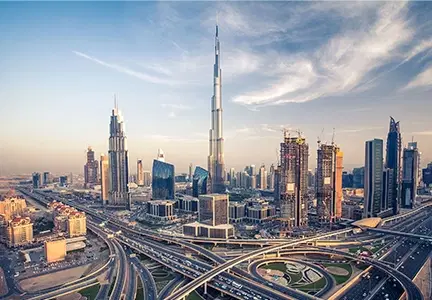In 1960s along with the finding of oil fields, it always became a prime spot for gold trade and after 6 years it started shipping gold Dubai worked on boosting the economy, and at that time the price of gold was $35.27 per ounce which was majorly supplied to India and about 56 million pounds was imported.
Dubai Took a Lucrative Step to Become Independent
So somehow, the economy of Dubai was going on the right path to improve the overall picture of Dubai, and for this, more lucrative steps were taken by Dubai that turned out the overall picture of this place, in 1971 The British Trucial Sheikdoms Treaty was ending on 1st December and became independent completely and after this, 6 of the emirates that were Sharjah, Ajman, Dubai, Umm Al Quwain, Fujairah and Abu Dhabi united to form UAE (United Arab Emirates), and then Dubai’s national currency was dirham that was better than their earlier currency Gulf Rupee.
And after 5 years, the opening of Jebel Ali Port boosted the number of trading and investment in Dubai and at that time it was the 9th busiest port in the world and also the biggest port in the Middle East.
1996: World Cup & Shopping Festival in Dubai
After this, the diversification was important and they hosted its first World Cup & shopping festival in 1996. This event attracted approximately half a million visitors who spent around US$ 500 million within a month which was one of the crucial additions to economic growth. Since then, the festival industry has been a big contributor, with over 3000 stores participating, this has created jobs for the people and provided an opportunity for around 700 brands to come up in this Dubai Shopping Festival.
This also added some new culture in Dubai to wear branded clothes, and not just this, in fact, the biggest gold chain, exclusive furniture, and mattress were introduced to change the way of living and add some unique items in the home to level up its beauty, and in this festival, the authentic biryani also called as Machboos was served as it is one of the famous dishes of Dubai.
1999: Burj Al Arab World’s 1st 7* Hotel
Jumeirah Burj Al Arab the tallest hotel which was ever built with 7 star facilities has added a different culture in Dubai for people to come out from their homes and experience this premium property that has every amenity to ameliorate the standard of experience, and its beauty was in its structure where giant sail shaped façade, installation of crystal and more showing its bold look where it has taken the travel industry of Dubai to another level as people wanted to come here to embrace this beauty on the desert.
For advertising, Tom Wright engraved a sketch of this hotel on the restaurant’s napkin so that everyone would know about this sought-after destination for luxury experiences around the world.
So, every prime development in Dubai was part of its culture to add newness to the lifestyle where people could witness growth and change in life. Not only this, but the picture was way larger as it employed 1,600 people from different countries, and this way, it had culture exchange.
Reflection of Modern Culture- Burj Khalifa
Dubai holds its Islamic culture in every place and its significance is also reflected in Burj Khalifa where many historical and cultural elements are infused. the façade of the building reflects the desert flower “Hymenocallis” and even the building is a replica of the onion dome of Islamic architecture, so every detail of this building shows the picture of Dubai.
To embrace its culture & vibes many tourists come here every year to have a panoramic view of Dubai that is beyond words and even its novel structure stands on a larger platform to allure in every sense, in fact, Burj Khalifa showcases Dubai’s art where different sculptures are shown and iconic play with lights showing country’s flag.
In fact, it welcomes artists to create their designs so that the best one is projected on its 109,252 Sqm screen, so this way the place supports Dubai art and encourages people to create an exclusive piece in order to show their skills on a larger scale.
Apart from this, its major impact on the economy where because of Burj Khalifa Dubai was gleaning the attention of people around the world, and also turning into a business, entertainment and leisure spot for a whole new experience.
Data revealed that it generates $621in tickets and attracts 17 million tourists every year.


.webp&w=828&q=75)




